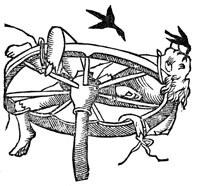https://dasmittelalterderblog.com/tag/radern/
The killing of another man Here in the Middle Ages was distinguished between murder, manslaughter and child murder. Murder was still atonementable with the Germans by the payment of the so-called "Wergelde". From the 12th century this changed. When murder was planned, another person was killed. The killing had to happen secretly and the murderer had to try to conceal the corpse before discovery. In addition, the killing by order, by striving for gain, a military or clueless was regarded as murder.
Wheels
Wheels
The punishments for murder are extremely brutal from today's point of view. Wheels are often called punishment. The condemned man was dragged to the rendezvous, fixed to the ground and then broken with a cartwheel joints and bones before killing him. If the court was gracious, the convicts were decapitated with the guilty sword. Women were buried alive, hanged, or burned. It is important to note that severe cases could lead to cumulation of the penalties. In practice this meant that punishment for other offenses before or during the murder could be added before the actual execution. The murder was distinguished from the manslaughter if this separation was not always sharply drawn. This offense, too, was generally punished with an execution, unless the accused had acted in self-defense, had made this under oath, and convinced the judge, in which case he was free. The killing of a child was a severe case of killing a defenseless man. As punishments were drowned, buried alive or piles of the perpetrator. Mothers who killed illegitimate newborns were, however, very rarely punished - mainly because there were no living people who suffered a disadvantage. As we see, secular law in the Middle Ages was rather pragmatic. [1]
The killing of another man Here in the Middle Ages was distinguished between murder, manslaughter and child murder. Murder was still atonementable with the Germans by the payment of the so-called "Wergelde". From the 12th century this changed. When murder was planned, another person was killed. The killing had to happen secretly and the murderer had to try to conceal the corpse before discovery. In addition, the killing by order, by striving for gain, a military or clueless was regarded as murder.
Wheels
Wheels
The punishments for murder are extremely brutal from today's point of view. Wheels are often called punishment. The condemned man was dragged to the rendezvous, fixed to the ground and then broken with a cartwheel joints and bones before killing him. If the court was gracious, the convicts were decapitated with the guilty sword. Women were buried alive, hanged, or burned. It is important to note that severe cases could lead to cumulation of the penalties. In practice this meant that punishment for other offenses before or during the murder could be added before the actual execution. The murder was distinguished from the manslaughter if this separation was not always sharply drawn. This offense, too, was generally punished with an execution, unless the accused had acted in self-defense, had made this under oath, and convinced the judge, in which case he was free. The killing of a child was a severe case of killing a defenseless man. As punishments were drowned, buried alive or piles of the perpetrator. Mothers who killed illegitimate newborns were, however, very rarely punished - mainly because there were no living people who suffered a disadvantage. As we see, secular law in the Middle Ages was rather pragmatic. [1]













